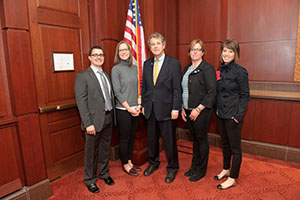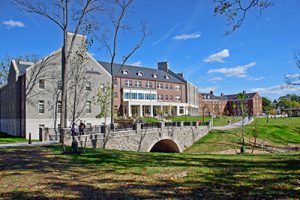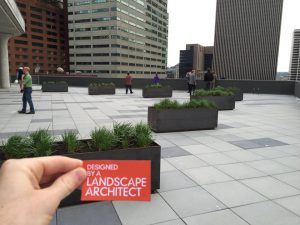Advocating for Landscape Architecture

 Last week, Lynne Nischwitz, the Landscape Architecture Studio Leader at the Kleingers Group, traveled to Washington DC as part of her role as Vice President of the Ohio American Society of Landscape Architects (ASLA) to advocate for landscape architecture and causes important to the profession.
Last week, Lynne Nischwitz, the Landscape Architecture Studio Leader at the Kleingers Group, traveled to Washington DC as part of her role as Vice President of the Ohio American Society of Landscape Architects (ASLA) to advocate for landscape architecture and causes important to the profession.
Each year ASLA sends landscape architects from across the country to Washington DC to raise the visibility of the profession with legislators and help promote the solutions that landscape architects can help provide to various national problems.
This year, the group was advocating for three things:
- Ensuring that bicycle and pedestrian paths and walkways continue to receive support in the latest Transportation Alternatives Program and are not subject to the same regulations as large highway projects.
- Protecting the Land and Water Conservation Fund which provides grants supporting the local park, conservation, trail, and recreation projects.
- Promoting the National Park Service Centennial challenge, ensuring money is available for the maintenance of the nation’s national parks.
The group also spoke about the importance of licensure in the landscape architecture profession. The education, experience, and examination required to earn a license ensures that licensed landscape architects can “keep the public safe from hazards, protect and maximize the use of natural systems and resources, and prevent damage to public or private property from changes in the built environment”, according to ASLA.
Lynne and fellow ASLA members met with Senator Rob Portman and Senator Sherrod Brown and Lynne also met with a representative from Steve Chabot’s office.
To learn more about the 2015 Advocacy Day or about the issues visit www.ASLA.org.
4 Ways the Kleingers Group Will Make Your Next Traffic Count Better
The Kleingers Group recently acquired unmanned bird’s eye perspective video capture devices, a new way to conduct traffic counts. Rather than requiring a person to stand at an intersection, the new technology converts images to data using video collected through a battery-operated camera.
The benefits to you are:
- Access to Multiple Days of Data at No Extra Cost: A traditional intersection traffic count only collects one day of data. Sometimes something unexpected happens, such as a crash on a nearby street that diverts traffic and creates a high count. With video capture devices, The Kleingers Group has access to several days of data to ensure the traffic count is giving a representative picture.
- Counts at Abnormal Locations (such as Roundabouts) at A Reduced Cost: Busy roundabouts are notoriously hard to count because the person counting has to follow the car along its entire path through the roundabout. Often roundabouts require multiple people to conduct a count, raising costs. With video capture, costs don’t increase.
- More Information than Just Numbers: Sometimes traffic patterns need to be observed to get the full picture. An intersection may be too busy for a person to count the traffic and simultaneously make notes of needed observations. Now, video can be reviewed directly, allowing the engineer to make the necessary observations, often at a sped-up rate. The end result is more information to help you make smart decisions.
- The Ability to Review Data at A Later Time: Sometimes specific questions about existing conditions don’t arise until after the traffic count is finished. With video capture, The Kleingers Group can go back and review the video on file to answer new questions, saving a repeat field visit.
Read how The Kleingers Group is using new technology to create an innovative parking solution on Blue Ash Road or contact The Kleingers Group to discuss how we can use video capture and smart analysis to help solve your traffic or parking problem.
What’s the Back-Up Plan? Changing the Parking Scheme on Blue Ash Road
Backing out of 90-degree on-street parking into a busy road is generally recognized as a very dangerous parking maneuver. Drivers often can’t get a good view of oncoming traffic before pulling into it, leading to driver anxiety and accidents.
So when The Kleingers Group started a safety improvement study for Blue Ash Road in the City of Deer Park, the existing 90-degree on-street parking was a major concern.
The transportation and infrastructure group used Miovision Scout Data Collectors—a camera that records video for use in data collection and observation—to observe parking maneuvers along the corridor. With video capture, they were able to cost-effectively perform over a day’s worth of observations at a birds-eye view.
What they found was surprising: a good portion of drivers were already backing into the existing 90-degree parking spaces to enable themselves to be able to see when they pulled out later.
This knowledge led The Kleingers Group to consider reverse angle parking, an innovative solution.
Unlike traditional angled parking, in which drivers pull into a space head-on, reverse angle parking encourages drivers to drive just past an open space and back in, vastly improving visibility when they pull out. The result is parking that is safer for both drivers, cyclists, and pedestrians.
Although reverse-angle parking is less common than traditional angled parking, the data from video observation showed that a culture of backing into on-street parking already existed.
“We learned that a good portion of drivers were already making maneuvers similar to the changes we were proposing,” Traffic Engineer Dave Meyer said. “Reverse angle parking will allow much greater visibility when you are exiting a parking spot.”
Although education campaigns will still be necessary to acquaint residents with the alternative parking scheme, many drivers won’t have to substantially change their habits. By encouraging the remaining drivers to also back into their parking space, accidents should be reduced and parking will be safer for motorists, cyclists, and pedestrians.
The result is increased economic development—including visitors, shoppers, and diners—as people feel safer parking and, as a result, frequenting the area.
Improvements to Blue Ash Road are expected to be completed in 2019.
Landscape Architecture Month: Designing a Better Community
April is World Landscape Architecture Month — a time dedicated to promoting landscape architecture to students and educating others about what it means to be a landscape architect.
Landscape architects are the people responsible for designing the parks, plazas, streetscapes, and green spaces that make the outdoors healthy, sustainable and enjoyable. At the Kleingers Group, we are proud of the role our landscape architects play in moving communities forward.
This month, we asked our landscape architects about why their profession is important, why they got involved, and what projects count among their favorites.
1. Why Are Landscape Architects Important?
“Landscape architects are important because they have the ability and skills to bring many different people and professions together to create improvements for the community. LA’s look at projects from a holistic approach, searching for the best solution.” – Michael
“Without landscape architects our world would be boring! Landscape architecture is not just about making things look pretty, its about creating and transforming spaces that initiate lifestyles and allow users to get outside and enjoy quality designed spaces. Landscape architects shape our built environment, they create spaces that function but are also aesthetically pleasing and designed to enhance the user’s quality of life.” – Ryan
2. What Inspired You to Become a Landscape Architect?
“I was inspired to enter the profession of landscape architecture when my parents decided it was time to spruce up their house. I was in middle school when they hired a landscape architect to completely transform their outdoor spaces. I immediately became interested in the process from reviewing plans, to choosing materials, to looking at plants. It wasn’t until I saw the finished product and the amazing transformation happen that I knew I wanted to do this for the rest of my life. After the transformation, the way we used our outdoor spaces changed. We no longer used the inside of our house for the majority of our activities, my family was outside as much as possible enjoying the amazing spaces that were created. I knew I wanted to design these spaces so everyone could have as much fun enjoying nature as I have.” – Ryan
“I first learned about the profession of landscape architecture from my dad, as he had graduated from Ohio State with a degree in Landscape Architecture. From listening to him talk about the profession, I knew that there was a lot more to landscape architecture than just designing planting plans. It was interesting to hear his stories about happenings that had occurred in the studio while drawing or something that happened in the field. It all sounded exciting. Because my dad graduated in landscape architecture from Ohio State, I remember seeing an alumni brochure he received in the mail showing the landscape architecture studio space. That sealed the deal for me, I thought it would be really cool to work in a creative studio environment.” – Lynne
“My senior year of undergrad, I took an environmental design class where I learned about landscape architecture for the first time. It combined many of my interests of design, the outdoors, etc. and the rest is history.” – Michael
3. Do You Have a Favorite Project that You Have Worked On?
“My favorite project I worked on was the Japanese American National Museum project in Los Angeles. It is my favorite project because it was the first project I worked on from concept design all the way through construction administration. I also loved the design of the project as well as the scale. It was also fun because George Takei, Sulu, from Star Trek was on the board of trustees of the Japanese American National Museum. I remember him being at a couple of meetings. I never watched Star Trek, so, I didn’t really care, but, it was funny to come back to the office and everyone would ask if George was at the meeting because they were Star Trek fans. The project also incorporated a fountain designed by Robert Murase.” – Lynne
“One of my favorite projects is one of my earliest ones that I did while working with LDR/HNTB in Maryland, called Carroll Creek. It transformed a desolate flood control infrastructure into an urban park, generating new business and residences for the city of Frederick, MD.” – Michael
“My favorite project I have worked on would be Miami University’s Western Campus. It was a large project with many different aspects. This project was a fast-paced project that allowed me to express a lot of creative freedom. Because the project was so fast paced, I was able to see how the design translated from paper to a real life application while the design was still fresh in my mind, which is pretty rare in our profession. Also, most my family members went to Miami University, so when we go up to oxford it also allows me take them to the project and brag about how cool the finished product is!” -Ryan
4. What Is Your Favorite Part of The Job?
“My favorite part of being a LA is seeing the physical impact on the community that our designs/projects have. To go to a public project (or a private one) and see people using it is the best reward.” – Michael
“I really enjoy most aspects of the profession because it is ever changing. I would say my absolute favorite portion would be the creative freedom we, as designers, are allowed. No two projects are alike, so it allows us to create unique new spaces with each project. The job is never monotonous and always keeps you interested and on your toes!” – Ryan
5. What Have You Done to Educate Others About the Profession?
“I serve as the Ohio Chapter VP of ASLA and therefore, I am working with our state legislators on advocacy for the profession. In fact, next week, I go to Washington D.C. to speak to our senators and representatives about issues relative to the landscape architecture profession. I have visited a class of kindergarteners and talked to them about landscape architecture and what we do as professionals. To show them in a way that they can relate, I asked them what they liked about parks and wrote down the list of things they liked to do at parks. Then, in a charrette style, right in front of them, I designed a park with all the elements they love. While doing so, I opened up their eyes that not only do landscape architects think about the fun stuff in a park, such as the playstructures, but also plan how the overall park is master planned and designed. For example, how you get to a park, (driving, walking or riding your bike), restroom facilities, parking areas, shade, and seating etc. and how all these elements work together.” – Lynne
“It is a constant education to explain to people that LA’s do more than backyards, golf courses or plants. To help get that message out there, I have spoken at conferences, public meetings, and just converse with people in general.” – Michael

